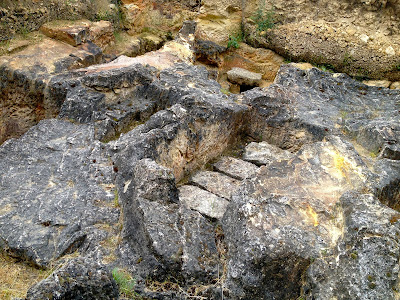 |
| Plaza de la Merced |
 |
| Old Jewish House |
 |
| Small winding street in the Jewish Quarter |
 |
| View of Segovia from the Jewish-tomb hillside |
 |
| Jewish Tomb Cave |
 |
| Stone tombs shaped like the body of a person |
Afterward, we walked back into town to see the old Jewish Synagogue, Corpus Christi, which is very close to the Plaza Mayor. From the inside, it looks like a typical synagogue with unique horseshoe arches and upper balconies where the women can pray and worship. It actually looked very similar to the synagogue we visited in Toledo! This one was a little less ornate, but we enjoyed being able to compare the two. Oddly enough, this synagogue was confiscated by the Catholic Church and the Crown in 1419 (shortly before the Spanish Inquisition) and was converted into a church where it received its current name, Corpus Christi (its original name as a synagogue was simply, Sinagoga Mayor. Anyway, The church burned down in 1899, but was reconstructed afterwards and is now open to the public, while also serving as a monastery.
 |
| Door to Corpus Christi |
 |
| Inside the Church of Corpis Christi |
 |
| Columns and arches inside the church |
 |
| News Article of the fire that burned down Corpus Christi |
 |
| Ricardo has the Key to the Church!! It's huge! |
We ended our tour of the Jewish Quarter by visiting the Didactic Center of the Jewish Quarter, which is a small museum. This center used to be the house of one of the most renown Jews in the 15th century, Abraham Senneor. He was a very important figure in assisting the Jewish integration into Segovia. He had great political and economic influence in the Segovian community and even served as a faithful servant to the Catholic Royalty during his time. Eventually Abraham converted to Christianity, receiving a new name, Fernán, Pérez Coronel. His house in Segovia seemed extremely large. It contained many different exhibits which helped us better understand Judaism. My favorite exhibit was the virtual synagogue which lit up on the wall and displayed a typical religious service. Overall, the Judería tour was extremely interesting, and an adventurous way to start off our day!
 |
| The Virtual Synagogue |
After the Judería, we returned home for lunch and siesta, or other activities before meeting back up at the school for our daily classtime. Today was a little different though because we had guest speaker, Julio de Olmo, who helped us better understand the current situation with the Law of Historic Memory in Spain. Julio serves as a volunteer who helps family members of those who were killed during the Spanish Civil War or during the Franco Dictatorship to find their bodies, which are mostly buried in mass graves throughout Spain. Julio gave us an abundance of information on the Civil War and the Franco Dictatorship, as well as information on what was occurring in the international community at the same time. It was interesting to hear his opinions about the Law of Historic Memory and Spain's contemporary history in general. This lecture certainly helped our class improve knowledge by providing us with an inside perspective on the extremely definitive events in Spain's history as well as its current situation. Yay!
No comments:
Post a Comment